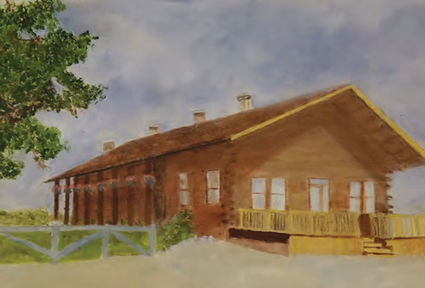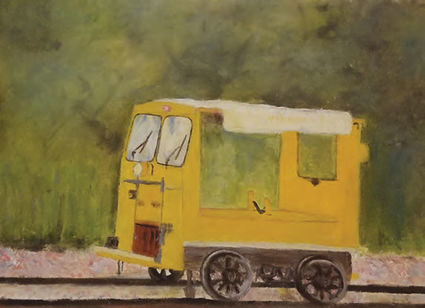WE END UP CLOSE TO HOME
Touched by the Milwaukee Road
July 8, 2020
At what seems a long, long time ago, we began this series with some backward glances at ranches, homesteads, and ruins in this vicinity. Subsequently, we rambled all over the State and broadened the topics, but now it's time to conclude, and we thought we'd do it in our own, extended neighborhood, just as we started. Naturally, we're still backward.
First of all, to get the piece rolling, here's another quiz question;
What did Richard Trevithick do?
That's right! He invented the steam locomotive. It was in England in 1802, but the idea exploded over the world, and here was a continent needing his creation for exploration and settling. Trains were vital in the United States, and they left an indelible mark in Montana.
Basically, as we all know, the notion was just a large-scale application of James Watt's slightly older one of the steam engine; water is heated by the combustion of some fuel, - coal, wood, or oil, - and the expanding steam drives the mechanism to produce mechanical energy. We should be grateful that it was Watt's name chosen to measure the power of a light. How cumbersome it would be to have to request a 75-Trevithick bulb!
Many readers will have seen the locomotive displayed in Harlowton, and it's part of the railroad museum there. It was an appropriate location for one, because in our limited micro-universe out here, Harlowton was known at one time as the railroad capital of the world. It was the place where railway companies stored supplies, spare parts, and everything required to keep trains running.
In track miles Harlowton was 113 miles to Billings (actually, at first to Coulson, which is a ghost town survived by its Boot Hill above Main Street in the Heights), and 113 miles to Miles City, the cow capital of this world. (We always think of Harlowton as the wind capital of the world and believe that, if it had been endowed with a supply of sand, Wilbur and Orville certainly would have picked it over Kittyhawk.)
To gain a little railroad perspective, a bit of rail history helps.
The Milwaukee Road and Waukesha Railroad, headquarters in Milwaukee, was incorporated in 1847. It was an era of numerous, small lines, and in 1861 this one bought the Milwaukee and St. Paul Railroad and moved its offices to Chicago in 1874.
Other lines were stretching out towards the Pacific, and in 1890 the Milwaukee Road said, "Why not us?" and decided to do the very same. By 1905 it realized this was a quite costly dream, and there were few land grants available to ease the expense of acquiring right-of-way. Additionally, there were mountain ranges, such as the Belt, Rocky, Bitterroot, Castle, and Crazy in the way.
Even so, they managed to negotiate the 2300 miles in 3 years, despite such obstacles as temperature; it was so cold that maintaining adequate steam was a problem, which made the trains slow at times. (One should not decide, however, that hotter is necessarily better, because if the water becomes warm too fast, it boils out without producing the desired steam.) Further, it did not augur well that the line paralleled the competing Northern Pacific, and the Milwaukee Road declared bankruptcy in 1925.
Now, if you or we became bankrupt, that would likely be the end of us, but companies have tricks for rising, Phoenix-like, from their own ashes and having another go. That was precisely what the Milwaukee Road did and in 1928 reopened as the Chicago, Milwaukee, St. Paul, and Pacific, which constructed luxury hotels along its route. This allowed it to transport profitable cargo in both directions, for it was the lucrative produce of the West that it would haul east.
There is an ominous note about the year 1928; 1929 was the very next one, and we know what happened then. The Depression brought the company another bankruptcy in 1935.
Down again, but not out, the line offered temporary services in World War II days, but, thanks to our excellent highway system, in the 1950s and 60s there was a general decline in railroad business. In the 70s it sought to merge with larger railroad companies but was bankrupt again in 1974. Three strikes and – still not entirely out.
There was a sort of immortality in this company, which in 1986 saw some of its assets become part of the Sioux Line, operating more modestly between Milwaukee and Minneapolis. Next the Milwaukee and Sioux was absorbed into the Canadian Pacific, and, finally, many of those miles and miles of unused right-of-way have become popular hiking or biking trails. While its trains, tracks, and ties may have vanished, the Milwaukee Road, possibly under its other names or incarnations, remains with us. Some of us may have walked, run, or cycled over it.
The steam locomotive, then, had appetites for water and fuel and required places to stop and take on rations of each. Consequently, the track was bordered by roughly equally-spaced service stations along its routes. The distance between was usually about six miles, which would have become tedious for passengers in a hurry to get somewhere. Some of the stops, at least their names, that we recognize today were established by the railroad solely for its requirements. Ingomar, Vananda, and Bascom are of this sort.
Because of the coal resources here and at Klein, Roundup was an important stop even discounting the livestock it shipped, and our town has at least one resident connected with railroad work. Margaret Goffena lives presently at Whispering Pines, and her mother was born at the Bascom train service settlement. In Roundup her father worked as a water pumper. Here, water for trains was taken from the river, and Jane's painting shows Roundup's familiar station building fulfilling nowadays a private function. By contrast, Bascom had a cistern filled by means of water cars that trains hauled from Melstone.
Driving by Vananda, one is struck, after the beautiful, empty school, by the aridity of the place, so there, too, seems an odd place for a water stop. The railroad, though, built a reservoir to store the precious fluid for its trains.
People were required to accomplish the operating and maintenance jobs, so the stops became settlements of varying sizes. It was typical to have a foreman's house, as well as workmen's living quarters, which latter may have been in a train car. We know of Meals on Wheels; these were Homes on Wheels.
A conveyance very useful in railroad maintenance work and track inspection was the speeder car. Also known as a putt-putt, jigger, trike, or other terms. It is a motorized vehicle that may resemble a cube on railway wheels or a box car compressed to a length of 8-9 feet with width and height 5-6 feet. Relatively misnamed, for it is nowhere nearly as speedy as a normal train, they have greater velocity than the human-powered handcar. Non-railway personnel living in the service communities were allowed some use of them which was a great convenience in places where roadways were poor and automobiles rather scarce. With the innovation of attaching rail wheels to ordinary motor vehicles, speeder cars passed out of commercial usage.
In some parts of the country railroad hobbyists purchase speeder cars and groups of owners organize excursions for their strange vehicles along sections of track reserved for them. Jane's painting depicts one of the sporting, midget cars.
With this brief sketch of regional railroad history and background, we'll be prepared to pursue next week a little review of Bascom, Montana, which has been our objective all along.
Some material in this and next week's articles was imparted by telephone interviews with Frank Vassau, Beartooth Museum at Columbus; Ken Mager, Railroad Museum at Harlowton; Frank (surname modestly withheld), Rosebud County Museum; and Shirley Parrot, Musselshell Valley Museum. Apologies to these generous informants for any misspellings of names, for where we live, clear telephone calls are a rarity.








Reader Comments(0)